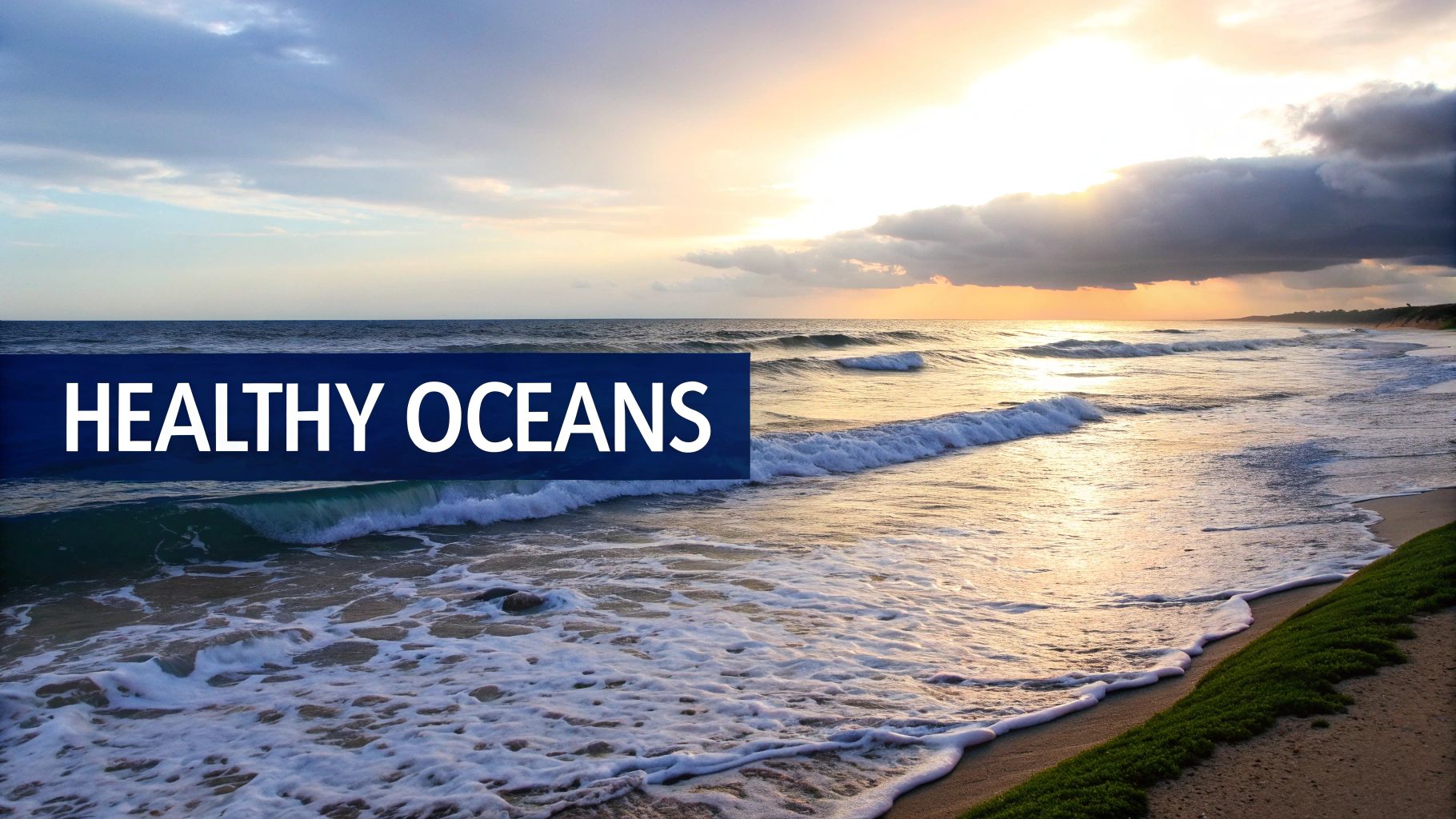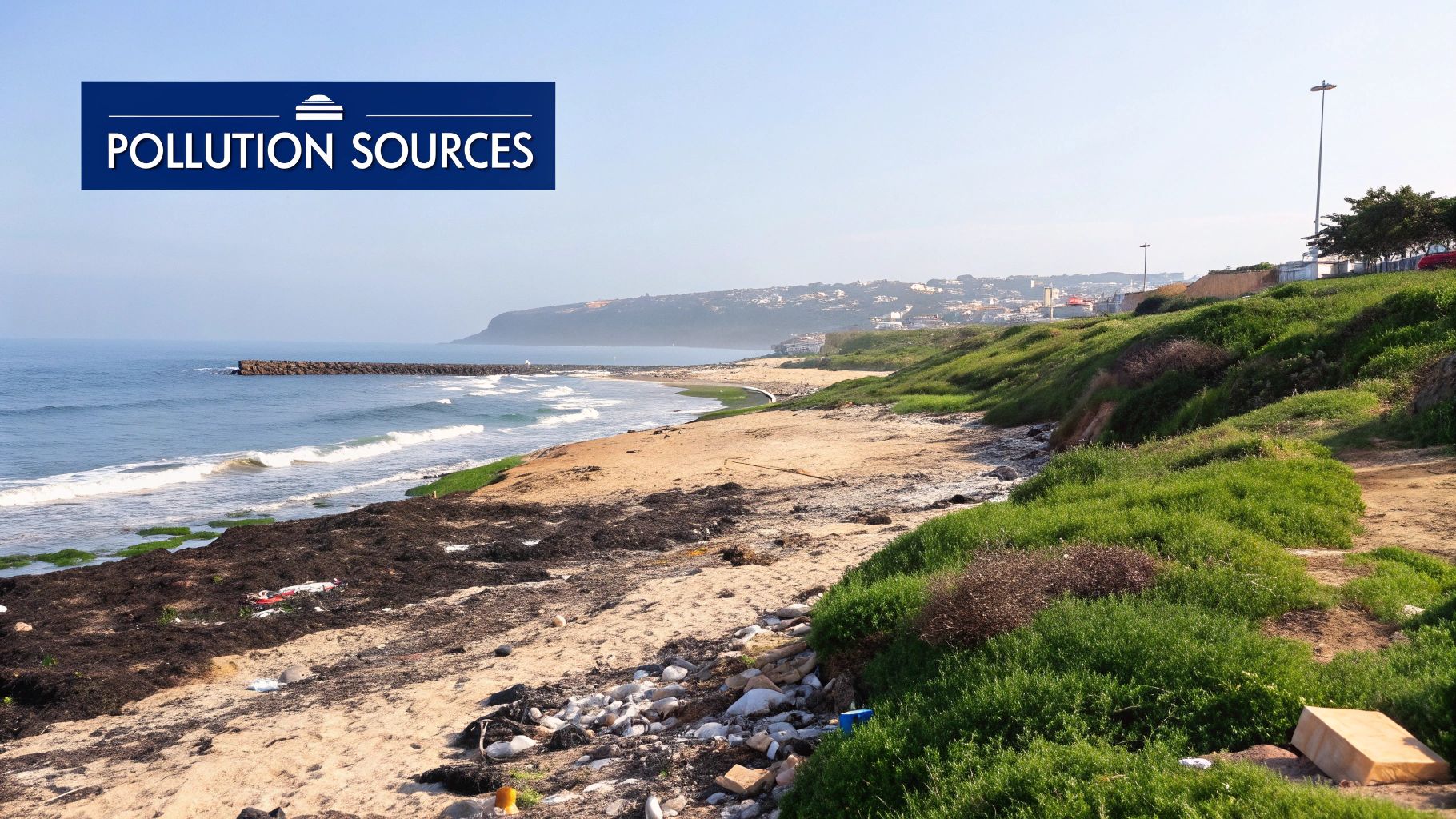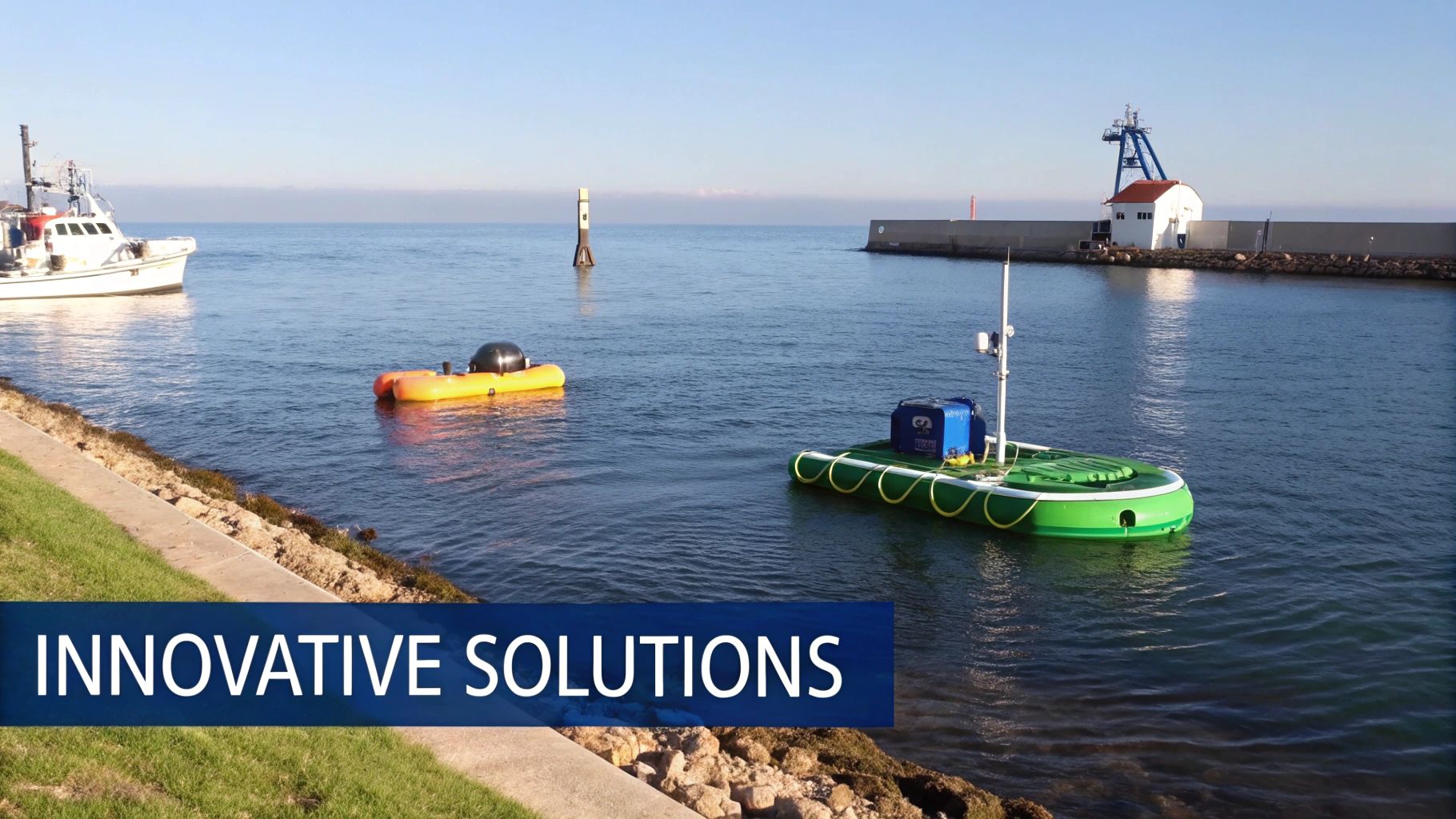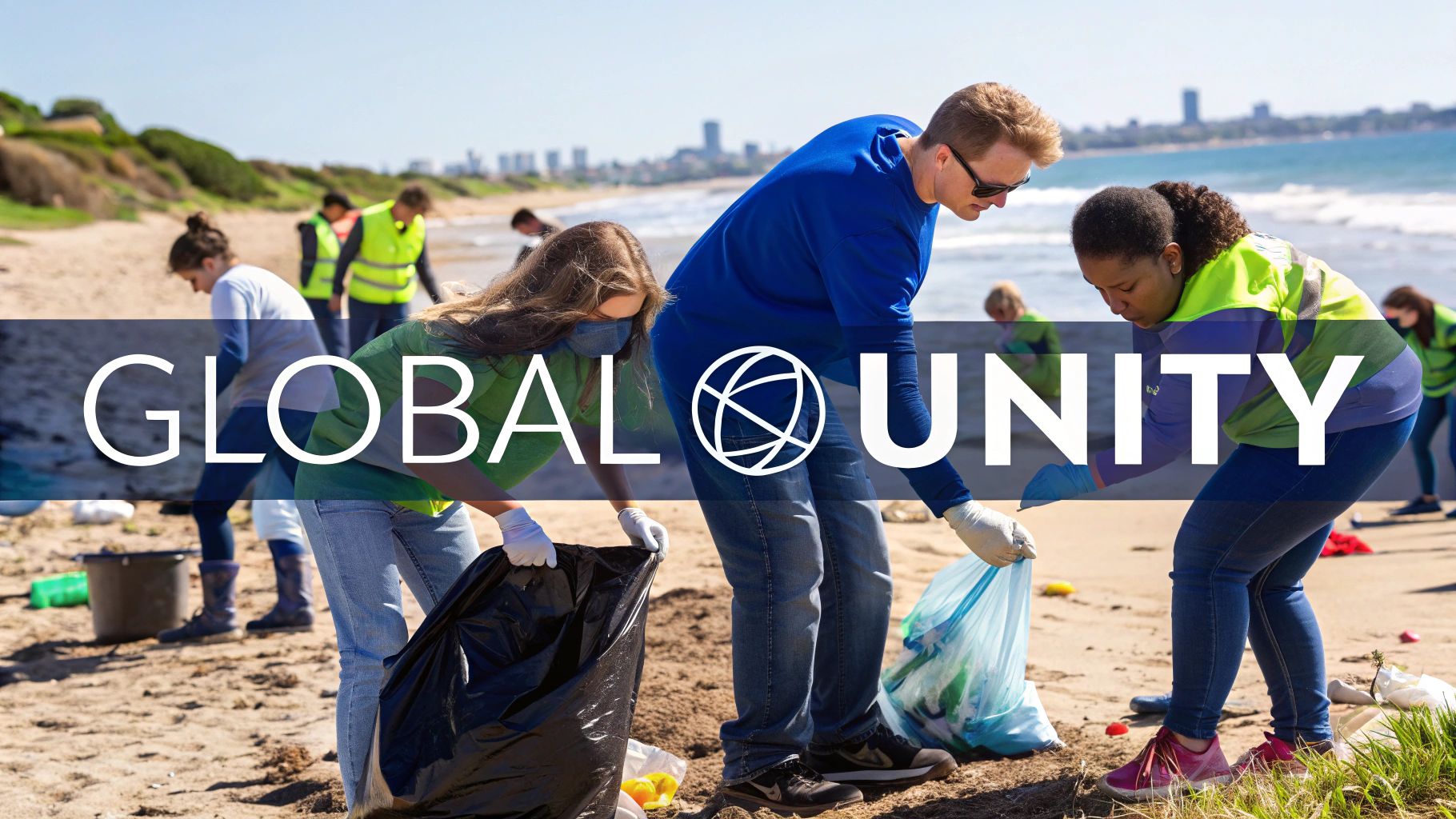The Growing Crisis Beneath the Waves

Our oceans are vital to the health of our planet. However, they're facing an enormous pollution crisis. This problem goes far beyond the trash we see on beaches. It impacts the entire marine ecosystem. Understanding the scale of this crisis is the first step towards finding solutions. We need to examine the different types of pollution and how they're entering our waters.
The Main Culprits: Identifying the Sources of Pollution
Marine pollution comes in various forms, each with its own harmful effects. Plastic waste is the most obvious and widespread pollutant. Chemical contaminants, stemming from industrial discharge and agricultural runoff, poison marine life and disrupt the balance of marine ecosystems.
Oil spills, while less common, create catastrophic damage, impacting wildlife for decades. Noise pollution from ships and other human activities interferes with marine animal communication and navigation. Even excess nutrients from fertilizers contribute to harmful algal blooms and create oxygen-depleted "dead zones." All these pollutants pose a severe threat to our oceans.
Pathways to Pollution: How Pollutants Enter Our Seas
Pollutants enter the ocean in several ways. River systems carry land-based waste and runoff into the sea. Direct disposal from ships and offshore platforms also contributes significantly. Atmospheric deposition, where pollutants are carried by wind and rain, introduces contaminants from far-off sources.
Understanding these pathways is key to developing effective solutions. For example, better waste management systems on land can lessen the flow of pollutants into rivers and, consequently, the ocean.
The Impact: A Cascade of Consequences
Marine pollution has widespread consequences, impacting all levels of marine life, from tiny plankton to massive whales. Ingestion of plastic by marine animals can lead to starvation, while entanglement in fishing gear causes injury and death. Chemical pollutants can disrupt reproduction and development.
These effects ripple through the food chain, eventually impacting human populations dependent on the ocean for food and livelihoods. Pollution also damages crucial habitats like coral reefs and seagrass beds. As of 2025, it is estimated that there are 75 to 199 million tonnes of plastic and waste in the oceans. Around 33 billion pounds of plastic enter the oceans every year. Around 80% of all marine debris is plastic, which equates to approximately 8 to 10 million metric tons annually. More detailed statistics can be found here: https://www.greenmatch.co.uk/ocean-pollution-facts. This destruction weakens the ocean's ability to regulate the climate, produce oxygen, and support biodiversity. Addressing marine pollution is essential for the ocean's health and the well-being of our planet.
Breaking Up With Single-Use Plastics

Single-use plastics are a major source of ocean pollution. These items aren't limited to just straws and bags. They include a wide variety of everyday products. Reducing our dependence on these plastics is essential for protecting our oceans. This means actively looking for alternatives and making changes to our buying habits.
Practical Alternatives: Swapping Convenience For Sustainability
Many people believe that environmentally friendly options are costly and difficult to use. However, there are plenty of affordable and easy alternatives available. Reusable water bottles, shopping bags, and food containers are great replacements for their disposable counterparts. This not only reduces plastic waste, but can also save money over time.
Consider using bamboo cutlery, beeswax wraps, and bar soap instead of liquid soap in plastic bottles. These simple changes can easily become part of our daily routines. Moving away from single-use plastics isn’t about a total lifestyle change. It’s about making conscious decisions about the products we use.
Let's take a closer look at some practical swaps you can make:
To help visualize these alternatives and their impact, here's a comparison table:
Single-Use Plastic Alternatives: This table compares common single-use plastic items with their sustainable alternatives, looking at cost and environmental benefits.
| Single-Use Item | Sustainable Alternative | Average Cost | Environmental Benefits | Lifespan |
|---|---|---|---|---|
| Plastic Grocery Bag | Reusable Shopping Bag | $1-5 | Reduces plastic waste, conserves resources | Years |
| Plastic Water Bottle | Reusable Water Bottle | $10-25 | Reduces plastic waste, conserves resources | Years |
| Plastic Food Wrap | Beeswax Wraps | $15-20 | Biodegradable, compostable | 1 Year |
| Plastic Cutlery | Bamboo Cutlery | $5-10 | Biodegradable, compostable | Years |
| Liquid Soap in Plastic Bottle | Bar Soap | $2-5 | Reduces plastic waste, minimal packaging | Months |
This table highlights the long-term cost savings and significant environmental advantages of choosing reusable options. The initial investment for sustainable alternatives often pays for itself through repeated use.
Building Lasting Habits: From Motivation to Action
Changing behavior takes more than just wanting to protect the environment. It requires building lasting habits. Starting small and gradually adopting more sustainable practices is a good strategy. For example, you could begin by replacing plastic grocery bags with reusable bags. Then, move on to other areas, such as reducing plastic packaging.
This gradual approach can help turn temporary motivation into a permanent lifestyle shift. Finding alternatives that are just as convenient, or even more so, is another useful technique. Carrying a reusable water bottle, for instance, can become as automatic as grabbing your keys.
Community Action: Amplifying Individual Efforts
Individual actions are important, but community initiatives can make a bigger difference. Programs like deposit return schemes, where consumers get a refund for returning plastic bottles, are very effective at reducing plastic waste. Learn more in our article about how to prevent marine pollution. These schemes encourage recycling and promote responsible waste management.
Collaborations between local businesses and communities can also drive positive change. For example, restaurants could offer discounts to customers who bring their own containers. They could also switch to compostable packaging. These types of partnerships create a sense of shared responsibility. They also show that sustainability can be good for both business and the environment.
Rethinking Our Relationship With Plastic: A Sustainable Future
Preventing marine pollution from single-use plastics requires a fundamental change in our thinking. We need to shift away from a throwaway culture and adopt a more sustainable approach. This means thinking about the entire lifecycle of a product, from its creation to its disposal. It also means making choices that minimize our environmental footprint.
Adopting this mindset can help create a future without plastic pollution. It's about understanding that our individual actions have a combined impact on the health of our oceans. It's about taking responsibility for our choices.
Waste Management Systems That Actually Work

Effective waste management is crucial for protecting our oceans. It's the first line of defense against pollution, stopping waste before it reaches the marine environment. This goes beyond simply collecting trash. It involves building systems that minimize waste creation and maximize resource recovery. We need to move past just shifting trash from one location to another and adopt a more holistic approach.
Beyond the Bin: Rethinking Waste Collection
Modern waste management begins with smart collection strategies. This includes optimizing routes for collection trucks and implementing separate collection streams for different materials. Think recyclables, organic waste, and regular trash. Technology also plays a vital role. For example, smart bins can alert waste management services when they are full. This reduces unnecessary trips and fuel consumption, improving overall efficiency. These improvements aren't just about saving money; they create the foundation for effective sorting and processing.
Sorting and Processing: Transforming Trash into Resources
After collection, waste needs to be sorted efficiently. This can be done manually, with automated systems using technologies like optical sorters, or a combination of the two. Effective sorting is key to maximizing recycling rates and minimizing the amount of waste sent to landfills. Advanced sorting systems can even separate different types of plastics, allowing for more specialized and effective recycling.
Once sorted, the various waste streams can be processed accordingly. This might involve:
- Recycling: Turning materials like paper, plastic, and metal into new products.
- Composting: Converting organic waste into valuable compost for gardens and agriculture.
- Anaerobic Digestion: Using microorganisms to break down organic matter and create biogas, a renewable energy source.
- Waste-to-Energy: Incinerating non-recyclable waste to generate electricity.
These processes help divert waste from landfills while also producing valuable resources.
Specialized Solutions: Addressing Problematic Waste Streams
Some types of waste require specific handling procedures. Electronic waste (e-waste), for instance, contains hazardous materials. These materials can pollute the environment if not managed correctly. Hazardous household waste, such as paints and cleaning products, also requires separate collection and processing.
Dedicated systems for these waste streams are essential. They help prevent these materials from polluting our oceans. Often, this involves collaborations with specialized recycling facilities and public awareness campaigns to promote proper disposal methods.
Adaptable Strategies: Solutions for All Communities
The Environmental Protection Agency (EPA) in the United States plays a critical role in ocean protection through its Ocean Dumping Management Program. This program regulates ocean dumping to safeguard both human health and the marine environment. You can learn more about protecting our oceans from pollution here. Effective waste management doesn't always require expensive technology. Adaptable strategies can be tailored for communities with varying resources. This might include community composting initiatives, educational programs to promote waste reduction, and partnerships with local organizations to create sustainable solutions. The goal is to identify practical and effective solutions that are appropriate for the local situation. This empowers every community, regardless of resources, to participate in preventing marine pollution. By prioritizing waste reduction, improving recycling rates, and implementing strategies for specific waste streams, we can make a real difference for the health of our oceans.
Cleaning Up Maritime Operations

The maritime industry is vital for global trade. However, it also contributes significantly to marine pollution. The good news is that this industry has the potential to create substantial positive change. Transforming maritime operations from polluters to protectors requires a multifaceted approach. This includes stricter regulations, advancements in technology, and a shift in the industry's mindset towards environmental stewardship.
Preventing Oil Spills: A Multi-Layered Approach
Oil spills are a devastating form of marine pollution. Preventing them requires a combination of preventative measures and rapid response strategies. Regular maintenance and inspections of vessels are critical for catching potential problems early. Improved navigation systems and crew training can also minimize the risk of accidents.
Accidents can still happen, so robust oil spill response plans are essential. These plans should include readily available equipment and trained personnel. This ensures spills can be contained and cleaned up quickly and effectively, minimizing long-term environmental damage.
Ballast Water Management: Minimizing Invasive Species
Ships use ballast water for stability. However, this water can transport invasive species, disrupting local ecosystems. Effective ballast water management is crucial to prevent this. Many modern ships now have ballast water treatment systems. These systems filter and sterilize the water before it is discharged.
Regulations requiring these treatment systems are becoming more common. This helps standardize this important preventative measure. However, ongoing research and development of even more effective treatment technologies are needed to fully address this issue.
Reducing Underwater Noise Pollution: Protecting Marine Life
Ships generate noise that can interfere with marine life. This noise pollution can disrupt animal communication and navigation, affecting their behavior and survival. Several strategies can mitigate this often overlooked form of pollution. Designing quieter ships with more efficient propellers and hull designs is one approach.
Operational changes, such as slowing ship speed in sensitive areas, can also help. Additionally, noise-reducing technologies, like air bubble curtains around ships, can minimize the impact on marine animals.
Addressing Vessel Abandonment: Preventing "Ghost Ships"
Abandoned vessels, or "ghost ships," are a significant pollution threat. They can leak oil and hazardous materials, and also become navigational hazards. There are approximately 3 million sunken and abandoned vessels in the ocean. Over 8,500 are classified as potentially polluting wrecks. Learn more about marine pollution from sunken vessels here.
These wrecks contain an estimated 6 billion gallons of heavy fuel oil. This amount surpasses the combined spills of the Exxon Valdez and Deepwater Horizon. Strengthening regulations around vessel disposal and promoting responsible ship ownership are key to preventing future abandonments.
Industry Initiatives and Best Practices: Leading the Way
Many shipping companies are going beyond regulatory compliance. They are adopting voluntary best practices to further reduce their environmental impact. This includes optimizing fuel efficiency to lower emissions and implementing waste management systems to minimize discharges. You might be interested in: how CLiX Fueling solutions can help. These initiatives show that environmental responsibility and economic viability are not mutually exclusive. By embracing these practices, the maritime industry can create a more sustainable future for our oceans. By focusing on prevention, mitigation, and responsible practices, the industry can significantly reduce its contribution to marine pollution and become a true steward of the oceans.
Tackling Land-Based Pollution at the Source
What happens on land significantly impacts our oceans. Marine pollution often originates from land-based sources, traveling through rivers, stormwater runoff, and even the air. This exploration examines how agricultural and industrial activities contribute to this issue and proposes solutions to break the pollution cycle.
Agriculture: From Farm to Ocean
Agricultural runoff is a major source of marine pollution. Fertilizers, pesticides, and animal waste introduce excess nutrients and harmful chemicals into our waterways. These pollutants contaminate rivers and streams, ultimately reaching the ocean. This runoff can lead to harmful algal blooms, depleting oxygen and creating “dead zones” where marine life struggles to survive. One example is the Gulf of Mexico dead zone, one of the largest in the world, primarily caused by agricultural runoff from the Mississippi River basin.
Sustainable farming practices, however, offer a path forward. Techniques like no-till farming, crop rotation, and the use of buffer strips can effectively reduce runoff and soil erosion, while also enhancing soil health. Integrated pest management and responsible fertilizer use minimize the reliance on harmful chemicals. These sustainable practices not only protect our oceans but can also improve long-term farm productivity.
Industry: Rethinking Waste Streams
Industrial activities, ranging from manufacturing to energy production, generate diverse pollutants. Wastewater discharge often carries heavy metals, chemicals, and microplastics, contaminating waterways. Air pollution from industrial facilities also contributes, as harmful substances can be deposited into the ocean through atmospheric deposition.
The circular economy concept is reshaping industrial waste management. This model emphasizes minimizing waste by reusing, repairing, and recycling materials. Some industries are finding innovative ways to utilize waste products as raw materials for other processes, creating a closed-loop system. This approach not only helps prevent pollution but also conserves resources and lowers operational costs.
Urban Runoff: Managing Stormwater
Urban areas contribute significantly to marine pollution through stormwater runoff. Rainwater washes pollutants such as oil, grease, and litter from streets and parking lots into storm drains, which often flow directly into rivers or the ocean. This runoff can deliver a mix of contaminants that harm marine ecosystems and reduce water quality.
Green infrastructure offers effective stormwater management techniques to combat this challenge. Solutions like rain gardens, permeable pavements, and green roofs absorb rainwater and filter out pollutants. These approaches mimic natural processes, integrating nature into urban environments.
To better understand the impact of various prevention methods, let's look at the following table:
Impact of Runoff Prevention Methods
Statistical comparison of different agricultural and industrial runoff prevention methods and their effectiveness in reducing marine pollution
| Prevention Method | Pollutant Reduction (%) | Implementation Cost | Time to See Results | Additional Benefits |
|---|---|---|---|---|
| No-Till Farming | 30-50 | Low-Moderate | 1-2 Years | Improved soil health, reduced erosion |
| Crop Rotation | 20-40 | Low | 1 Year | Increased soil fertility, pest control |
| Buffer Strips | 40-60 | Low-Moderate | Immediate-1 Year | Habitat creation, enhanced biodiversity |
| Circular Economy Practices | Varies widely | Moderate-High | Varies widely | Resource conservation, cost savings |
| Rain Gardens | 50-70 | Moderate | Immediate | Aesthetic improvement, urban heat island reduction |
| Permeable Pavements | 60-80 | Moderate-High | Immediate | Reduced flooding, groundwater recharge |
| Green Roofs | 40-60 | High | Immediate | Improved air quality, energy efficiency |
This table summarizes the varying effectiveness and costs associated with each method, highlighting the trade-offs involved in selecting the most appropriate approach. As seen, while some methods like green roofs have a higher implementation cost, they offer immediate benefits. Other methods, like no-till farming, take longer to produce results but come at a lower cost.
Integrated Watershed Protection: A Collaborative Approach
Effective, long-term solutions require collaboration. Integrated watershed protection programs connect various stakeholders, including government agencies, businesses, farmers, and community groups to address pollution at the watershed level. A watershed is an area where all water drains to a common point like a river or lake.
By working together, stakeholders can develop and implement comprehensive plans that address all pollution sources within a watershed. This collaborative approach is essential for measurable water quality improvements and protecting our oceans from land-based pollution. Ultimately, safeguarding our oceans means addressing pollution at its source. By shifting towards sustainable agricultural and industrial practices and embracing efficient stormwater management, we can significantly reduce the flow of land-based pollutants into our oceans and protect these vital ecosystems.
Global Solutions for a Shared Ocean
Marine pollution is a major global issue demanding international collaboration. No single country can tackle this alone. Effective solutions require cooperation between governments, organizations, and individuals worldwide. We must see the ocean as a shared resource and work together to protect it.
International Frameworks: Setting the Stage for Cooperation
Several international agreements and organizations provide a framework for global action on marine pollution. The UN Convention on the Law of the Sea (UNCLOS) is a cornerstone of ocean governance. It sets rules for maritime activities and addresses pollution from ships. The Global Programme of Action for the Protection of the Marine Environment from Land-based Activities (GPA) focuses on reducing pollution from sources on land, such as agricultural runoff and industrial discharge. These frameworks establish the legal and political basis for joint efforts.
The United Nations has set ambitious goals to combat marine pollution, including significantly reducing it by 2025 (Goal 14.1). Achieving this requires international cooperation to create protected marine areas, reduce plastic use, and implement sustainable fishing. Learn more about the UN's Sustainable Development Goals for the oceans here. These global initiatives show the growing recognition of marine pollution as a shared problem.
CLiX Fueling Solutions offers solutions to help reduce spills.
Policy Tools: Implementing Effective Strategies
Beyond international agreements, various policy tools are being used to address marine pollution. Extended Producer Responsibility (EPR) schemes hold producers responsible for the end-of-life management of their products. This encourages them to design products that are easier to recycle and reuse, reducing plastic waste and promoting a circular economy.
Plastic taxes and levies can discourage single-use plastics while also generating revenue. This money can be invested in waste management and cleanup efforts. Marine Protected Areas (MPAs) help conserve biodiversity and offer refuge for marine life. MPAs strengthen ecosystem resilience to pollution and other stresses. These policies offer practical ways to reduce pollution and protect marine ecosystems.
Case Studies: Success Through Collaboration
Several examples show how effective international collaboration can be in tackling marine pollution. The OSPAR Convention for the protection of the North-East Atlantic is a regional agreement that has significantly reduced pollution from oil and gas platforms. This demonstrates the power of regional cooperation to address specific pollution problems.
The Helsinki Convention on the Protection of the Marine Environment of the Baltic Sea Area brings together Baltic Sea countries to address pollution from land-based sources and shipping. These cases highlight the importance of creating solutions tailored to specific regional situations and working together across borders.
Balancing Conservation and Sustainable Use
Effective ocean governance requires a balance between conservation and sustainable resource use. Many coastal communities rely on the ocean for their livelihoods, so policies must consider their needs while also protecting marine ecosystems. This involves creating sustainable fisheries, promoting eco-tourism, and investing in alternative livelihoods that lessen pressure on ocean resources.
By considering these factors, we can build a more sustainable and equitable future for both people and the ocean. International cooperation is vital for addressing the complex challenge of marine pollution. Through strong frameworks, innovative policies, and collaborative initiatives, we can create a healthier and more resilient ocean for future generations.
Your Personal Blueprint for Ocean Protection
Individual actions, when multiplied across communities, have a powerful impact on marine protection. This section provides a practical blueprint for contributing meaningfully to ocean health. We'll go beyond general environmental tips and explore research-backed strategies for tangible results, from mindful consumption to responsible tourism.
Rethinking Consumption: Minimizing Your Plastic Footprint
One of the most impactful steps you can take is reducing your reliance on single-use plastics. Think about your daily routine: how many plastic items do you use only once? Swapping disposable water bottles for a reusable one, bringing your own shopping bags to the grocery store, and choosing products with minimal plastic packaging are simple yet effective changes.
Consider buying laundry detergent in cardboard boxes instead of plastic jugs, or purchasing bar soap instead of liquid soap in plastic bottles. These small shifts in buying habits can significantly reduce your plastic waste and minimize your contribution to the global plastic problem.
Responsible Tourism: Protecting Marine Ecosystems While Traveling
Your travel choices, whether visiting a coastal town or a far-off island, impact the health of marine ecosystems. Choose eco-friendly tour operators that prioritize sustainability and minimize their environmental impact.
Avoid activities that harm marine life, such as touching coral reefs or disturbing nesting sea turtles. When enjoying the beach, pack out everything you pack in, leaving no trace behind. If you're planning a diving trip, choose an operator committed to responsible diving practices, like avoiding contact with the reef and picking up any trash they encounter. By making informed travel and leisure decisions, you can enjoy the beauty of our oceans without compromising their health.
Leveraging Your Consumer Power: Influencing Corporate Behavior
As consumers, our choices send powerful signals to businesses. By supporting companies that prioritize sustainability and avoiding those that contribute to marine pollution, we can encourage positive change. Look for brands that use eco-friendly packaging, reduce plastic in their products, and actively support marine conservation efforts.
Don't hesitate to contact companies directly and express your concerns about their environmental practices. Let them know you appreciate their sustainable efforts or that you're choosing a competitor due to their commitment to environmental responsibility. This feedback can influence corporate decision-making and drive a shift toward more sustainable practices.
Community Engagement: Amplifying Your Impact
Individual actions are important, but working together creates even greater change. Join local beach cleanups, participate in community recycling initiatives, and support organizations working to protect marine ecosystems. Engage with your local government and advocate for policies that address marine pollution.
Organizations like The Ocean Cleanup and the Seabin Project are working toward these goals by developing technologies to remove plastic from oceans and waterways. Initiatives like reducing single-use plastics and improving recycling rates are crucial for preventing further pollution and ensuring a sustainable future for marine ecosystems. Find more detailed statistics here: https://www.un.org/sustainabledevelopment/oceans/.
By joining forces with others, you can amplify your impact and create a stronger voice for ocean conservation. Even small actions, multiplied across a community, can significantly improve ocean health.
Whether you live near the coast or hundreds of miles inland, your everyday choices make a difference in the fight against marine pollution. By adopting these strategies and becoming a conscious consumer, responsible traveler, and active community member, you can be a powerful advocate for ocean health.
Ready to take the next step in protecting our oceans? CLiX Fueling Solutions offers a spill-free fueling system for boats, preventing harmful fuel leaks into marine ecosystems. Learn more at https://clixfueling.com.











